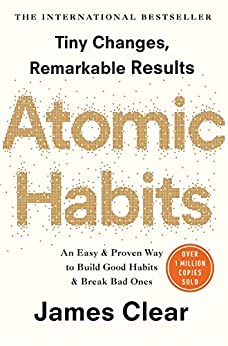Atomic Habits Book Review
Atomic Habits by James Clear is a bestseller that has sold more than a million copies worldwide. It is about transforming your life through tiny changes in behaviour. These small changes will have a revolutionary effect on your career, your relationships, and your life.
A habit is a routine or behavior that is performed regularly—and, in many cases, automatically. Changes that seem small and unimportant at first will compound into remarkable results if you’re willing to stick with them for years.
How to use this book?
The author’s advice is to use the book as an operating manual and the book is indeed filled with practical nuances and techniques to form new good habits or break bad habits.
This book is not an academic research paper; it’s an operating manual. You’ll find wisdom and practical advice front and center as I explain the science of how to create and change your habits in a way that is easy to understand and apply.
The fields I draw on—biology, neuroscience, philosophy, psychology, and more—have been around for many years.
What I offer you is a synthesis of the best ideas smart people figured out a long time ago as well as the most compelling discoveries scientists have made recently.
– James Clear
Personally the Two-minute rule resonated with me. I followed a similar thought process years ago when I bought a basic elliptical-cum-stationary bike for home. If I couldn’t bring myself to exercise for a few minutes in the comfort of my home in all seasons, then there’s no way I would be disciplined in visiting a gym. While the machine is good condition due to my sparing use, my bank balance is higher through savings on gym fees.
Is Atomic Habits worth reading?
The book is well worth your time. The summary is just a teaser trailer before you read the book. Must read in my opinion to those who want to get onto a journey of personal growth.
PS: I loved the Appendix even more and that’s not covered by the book summary.
PPS: The author has a great website. He is also active on his Twitter handle @JamesClear. Follow it and while you are at it also follow my Twitter handle @Reading_Guru. You won’t regret following either :).
Atomic Habits Book Summary
Note: This summary is made up of my notes, thoughts and highlights of important passages while reading the book. I keep updating the summary when I revisit it, and occasionally may edit it to reduce summary length. Don’t be surprised if it has changed between visits. The author’s words are in normal font, while my interpretations are in italics.
THE FUNDAMENTALS
Why Small Habits Make a Big Difference
- The effects of small habits compound over time. For example, if you can get just 1 percent better each day, you’ll end up with results that are nearly 37 times better after one year.
- Habits are the compound interest of self-improvement.
- Success is the product of daily habits—not once-in-a-lifetime transformations.
- You should be far more concerned with your current trajectory than with your current results.
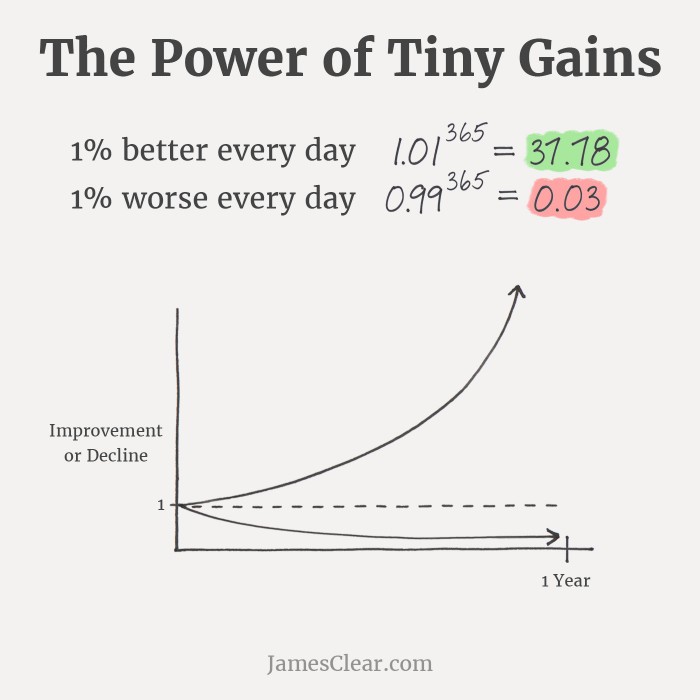
Your outcomes are a lagging measure of your habits.
Your net worth is a lagging measure of your financial habits.
Your weight is a lagging measure of your eating habits.
Your knowledge is a lagging measure of your learning habits.
Your clutter is a lagging measure of your cleaning habits.
You get what you repeat.
- Time magnifies the margin between success and failure. It will multiply whatever you feed it.
- Good habits make time your ally. Bad habits make time your enemy.
What progress is really like
- Breakthrough moments are often the result of many previous actions, which build up the potential required to unleash a major change.
- Habits often appear to make no difference until you cross a critical threshold and unlock a new level of performance.
- It’s a hallmark of any compounding process: the most powerful outcomes are delayed. The outside world only sees the most dramatic event rather than all that preceded it.
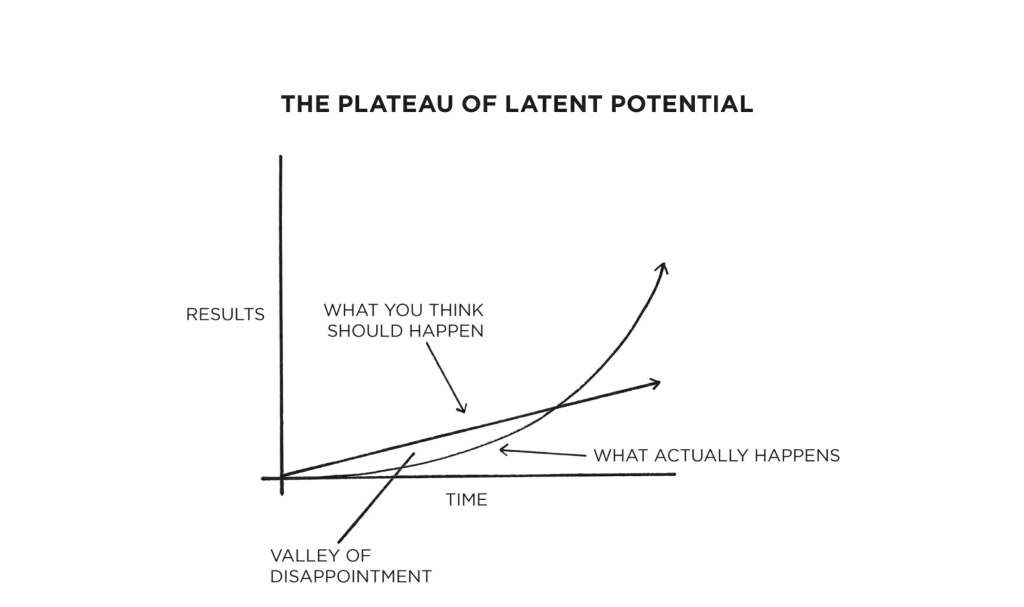
All big things come from small beginnings.
The seed of every habit is a single, tiny decision.
Forget about goals, focus on systems
Goals are about the results you want to achieve. Systems are about the processes that lead to those results.
Goals are good for setting a direction, but systems are best for making progress.
There are a few problems with Goals:
- Problem #1: Winners and losers have the same goals. Goal setting suffers from a serious case of survivorship bias.
- Problem #2: Achieving a goal is only a momentary change. We think we need to change our results, but the results are not the problem. What we really need to change are the systems that cause those results.
- Problem #3: Goals restrict your happiness. You are continually putting happiness off until the next milestone and create an ‘either-or’ conflict: either you achieve your goal and are successful or you fail and you are a disappointment. When you fall in love with the process rather than the product, you don’t have to wait to give yourself permission to be happy. You can be satisfied anytime your system is running.
- Problem #4: Goals are at odds with long-term progress. When all of your hard work is focused on a particular goal, what is left to push you forward after you achieve it? True long-term thinking is goal-less thinking. It’s not about any single accomplishment. It is about the cycle of endless refinement and continuous improvement.
A System of Atomic Habits
- You do not rise to the level of your goals. You fall to the level of your systems.
- An atomic habit refers to a tiny change, a marginal gain, a 1 percent improvement.
- Atomic habits—a regular practice or routine that is not only small and easy to do, but also the source of incredible power; a component of the system of compound growth
HOW HABITS CHANGE YOUR IDENTITY
Changing our habits is challenging for two reasons:
- We try to change the wrong thing and
- We try to change our habits in the wrong way.
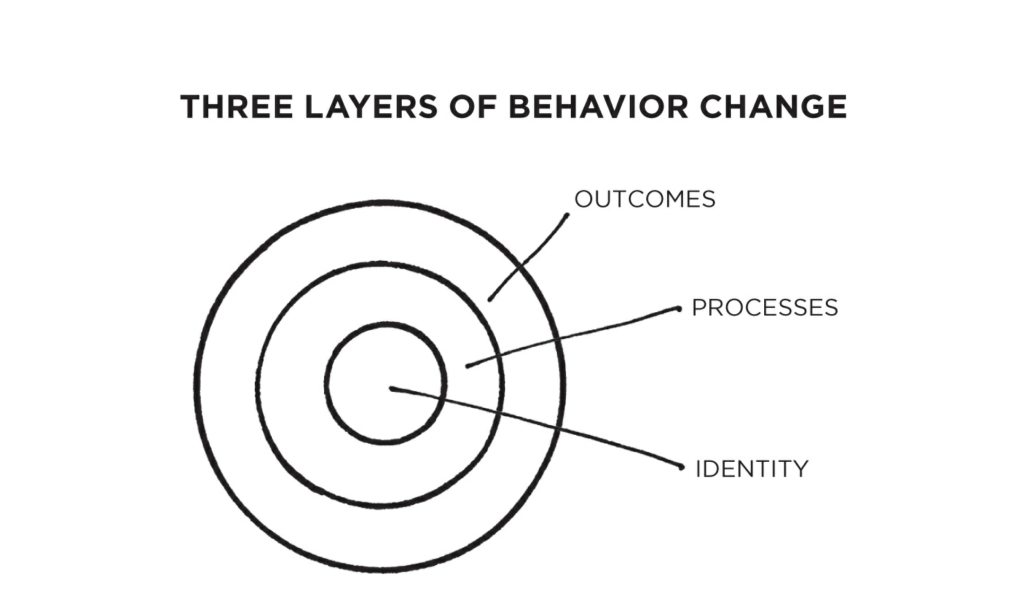
There are three layers of behavior change:
- A change in your outcomes. This level is concerned with changing your results: losing weight, publishing a book, winning a championship.
- A change in your processes. This level is concerned with changing your habits and systems: implementing a new routine at the gym, de-cluttering your desk and so on.
- A change in your identity. The deepest layer is changing your identity. This level is concerned with changing your beliefs: your worldview, your self-image.
Outcomes are about what you get.
Processes are about what you do.
Identity is about what you believe.
- Many people begin the process of changing their habits by focusing on what they want to achieve. This leads us to outcome-based habits.
- With identity-based habits, we start by focusing on who we wish to become.
For example:
When offered a smoke, one person says, “No thanks. I’m trying to quit.” It sounds like a reasonable response, but this person still believes they are a smoker who is trying to be something else.
The second person declines by saying, “No thanks. I’m not a smoker.” It’s a small difference, but this statement signals a shift in identity. Smoking was part of their former life, not their current one.
- Your behaviors are usually a reflection of your identity.
- Identity change is the North Star of habit change.
- Behavior that is incongruent with the self will not last. You may want more money, but if your identity is someone who consumes rather than creates, then you’ll continue to be pulled toward spending.
- The ultimate form of intrinsic motivation is when a habit becomes part of your identity.
- It’s one thing to say I’m the type of person who wants this. It’s something very different to say I’m the type of person who is this.
- The more pride you have in a particular aspect of your identity, the more motivated you will be to maintain the habits associated with it.
True behavior change is identity change.
You might start a habit because of motivation, but the only reason you’ll stick with one is that it becomes part of your identity.
..
The goal is not to read a book, the goal is to become a reader.
The goal is not to run a marathon, the goal is to become a runner.
- Your identity is not set in stone. You have a choice in every moment.
- Becoming the best version of yourself requires you to continuously edit your beliefs, and to upgrade and expand your identity.
Two-step process to changing your identity
- Your identity emerges out of your habits.
- You are not born with preset beliefs. Every belief, including those about yourself, is learned and conditioned through experience.
- The more you repeat a behavior, the more you reinforce the identity associated with that behavior.
Every action you take is a vote for the type of person you wish to become.
It is a simple two-step process:
- Decide the type of person you want to be.
- Prove it to yourself with small wins.
BUILD BETTER HABITS IN 4 STEPS
Why your brain builds habits
A habit is a behavior that has been repeated enough times to become automatic.
- As habits are created, the level of activity in the brain decreases.
- Your brain skips the process of trial and error and creates a mental rule: if this, then that.
- Habits are mental shortcuts learned from experience.
- The primary reason the brain remembers the past is to better predict what will work in the future.
- Habits reduce cognitive load on the brain and free up mental capacity, so you can allocate your attention to other tasks.
- Habits do not restrict freedom. They create it. Without good financial habits, you will always be struggling for the next dollar. Without good health habits, you will always seem to be short on energy.
THE HABIT LOOP
The process of building a habit can be divided into four simple steps: cue, craving, response, and reward.
- Cue – The cue triggers your brain to initiate a behavior. It is a bit of information that predicts a reward.
- Craving – they are the motivational force behind every habit. Without craving a change—we have no reason to act. What you crave is not the habit itself but the change in state it delivers. The thoughts, feelings, and emotions of the observer are what transform a cue into a craving.
- Response – The response is the actual habit you perform, which can take the form of a thought or an action. Whether a response occurs depends on how motivated you are and how much friction is associated with the behavior. A habit can occur only if you are capable of doing it.
- Reward – Rewards are the end goal of every habit. The cue is about noticing the reward. The craving is about wanting the reward. The response is about obtaining the reward. We chase rewards because they serve two purposes: (1) they satisfy us and (2) they teach us.
In summary, the cue triggers a craving, which motivates a response, which provides a reward, which satisfies the craving and, ultimately, becomes associated with the cue.
Together, these four steps form a neurological feedback loop—cue, craving, response, reward; cue, craving, response, reward—that ultimately allows you to create automatic habits. This cycle is known as the habit loop.
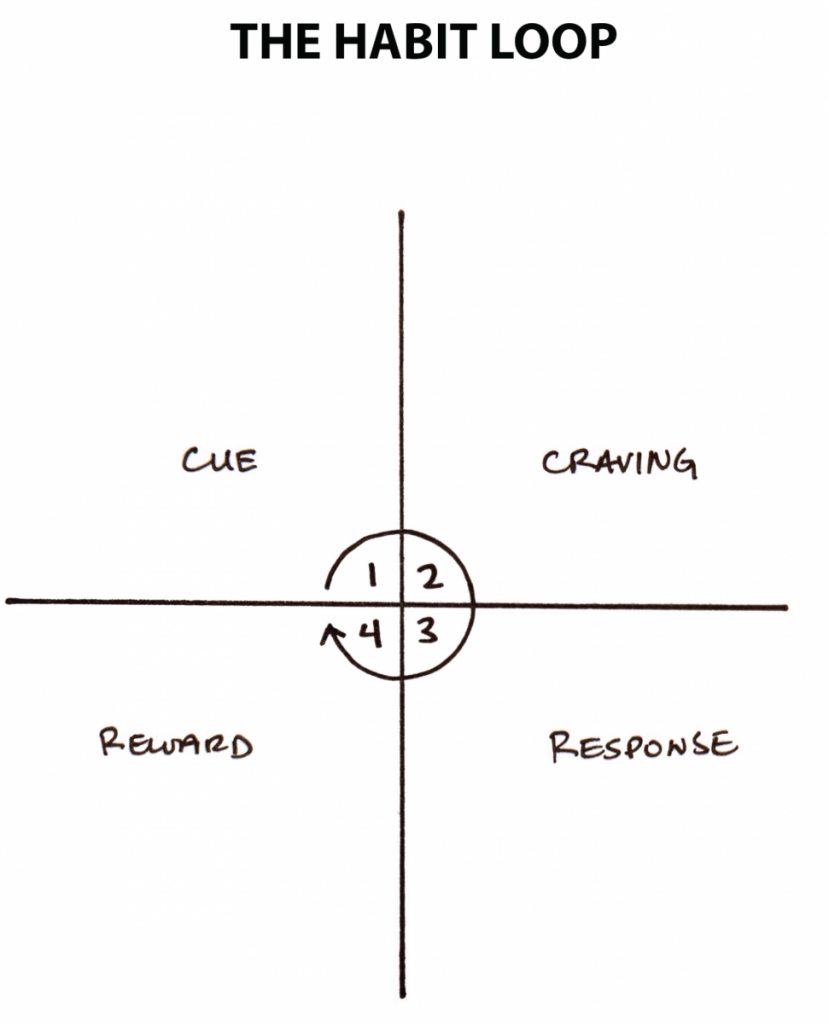
The habit loop has two phases:
- The problem phase includes the cue and the craving, and it is when you realize that something needs to change.
- The solution phase includes the response and the reward, and it is when you take action and achieve the change you desire.
The Four Laws of Behaviour Change
Below are the four laws to building new habits or breaking bad ones.
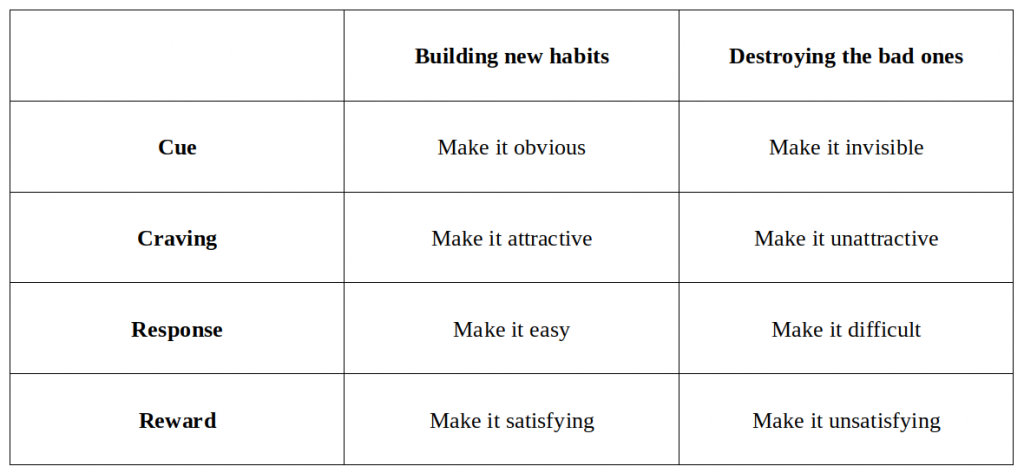
THE 1ST LAW – MAKE IT OBVIOUS
Many of our failures in performance are largely attributable to a lack of self-awareness. The process of behavior change always starts with awareness.
Implementation intention is a plan you make beforehand about when and where to act.
- People who make a specific plan for when and where they will perform a new habit are more likely to follow through.
- The simple way to apply this strategy to your habits is to fill out this sentence: I will [BEHAVIOR] at [TIME] in [LOCATION].
- When your dreams are vague, it’s easy to rationalize little exceptions all day long and never get around to the specific things you need to do to succeed.
Give your habits a time and a space to live in the world.
One of the best ways to build a new habit is to identify a current habit you already do each day and then stack your new behavior on top. This is called habit stacking.
- The habit stacking formula is: “After [CURRENT HABIT], I will [NEW HABIT].”
- Habit stacking increases the likelihood that you’ll stick with a habit by stacking your new behavior on top of an old one.
- Habit stacking works best when the cue is highly specific and immediately actionable.
How to design your environment for success
- If you want to make a habit a big part of your life, make the cue a big part of your environment. For example: If you forget your workplace ID, keep it next to your car keys.
- The most persistent behaviors usually have multiple cues.
- Be the designer of your world and not merely the consumer of it.
Context is the cue
- Stop thinking about your environment as filled with objects. Start thinking about it as filled with relationships.
- It is easier to associate a new habit with a new context than to build a new habit in the face of competing cues. For example, create a separate space for work, study, exercise, entertainment, and cooking. The mantra I find useful is “One space, one use.”
- Whenever possible, avoid mixing the context of one habit with another.
Self control
“Disciplined” people are better at structuring their lives in a way that does not require heroic willpower and self-control.
The people with the best self-control are typically the ones who need to use it the least.
It is easier to avoid temptation than resist it.
THE 2ND LAW – MAKE IT ATTRACTIVE
Habits are a dopamine-driven feedback loop.
- Dopamine is released not only when you experience pleasure, but also when you anticipate it.
- Whenever dopamine rises, so does your motivation to act. It is the anticipation of a reward—not the fulfillment of it—that gets us to take action.
Temptation bundling works by linking an action you want to do with an action you need to do.
- You’re more likely to find a new behavior attractive if you get to do one of your favorite things at the same time.
- If you want to check Facebook, but you need to exercise more: After I pull out my phone, I will do ten burpees (need). After I do ten burpees, I will check Facebook (want).
- The habit stacking + temptation bundling formula is: After [CURRENT HABIT], I will [HABIT I NEED]. After [HABIT I NEED], I will [HABIT I WANT].
Social Norms and Habits
We don’t choose our earliest habits, we imitate them. We imitate the habits of three groups in particular:
- The close. Join a culture where (1) your desired behavior is the normal behavior and (2) you already have something in common with the group.
- The many. Whenever we are unsure how to act, we look to the group to guide our behavior. The normal behavior of the tribe often overpowers the desired behavior of the individual. When changing your habits means challenging the tribe, change is unattractive.
- The powerful. We are drawn to behaviors that earn us respect, approval, admiration, and status. Once we fit in, we start looking for ways to stand out. We try to copy the behavior of successful people because we desire success ourselves.
How to reprogram your brain to enjoy hard habits
- Reframing your habits to highlight their benefits rather than their drawbacks is a fast and lightweight way to reprogram your mind and make a habit seem more attractive.
- Motion. When you’re in motion, you’re planning and strategizing and learning. Those are all good things, but they don’t produce a result.
- Action is the type of behavior that will deliver an outcome.
If you want to master a habit, the key is to start with repetition, not perfection.
THE 3RD LAW – MAKE IT EASY
How long does it take to form a new habit
Hebb’s Law: Neurons that fire together wire together.
The more you repeat an activity, the more the structure of your brain changes to become efficient at that activity. Neuroscientists call this long-term potentiation.
- Automaticity is the ability to perform a behavior without thinking about each step, which occurs when the nonconscious mind takes over.
- You could do something twice in thirty days, or two hundred times. It’s the frequency that makes the difference.
In a sense, every habit is just an obstacle to getting what you really want.
Dieting is an obstacle to getting fit.
Meditation is an obstacle to feeling calm.
Journaling is an obstacle to thinking clearly.
You don’t actually want the habit itself. What you really want is the outcome the habit delivers.
Achieving more with less effort
- When deciding where to practice a new habit, it is best to choose a place that is already along the path of your daily routine.
- Remove little bits of friction from your life. Business is a never-ending quest to deliver the same result in an easier fashion.
Prepare the environment for future use
People think I work hard but I’m actually really lazy. I’m just proactively lazy.
- Whenever you organize a space (make your bed, clear your desk) for its intended purpose, you are priming it to make the next action easy.
- Researchers estimate that 40 to 50 percent of our actions on any given day are done out of habit.
The two-minute rule
[This is probably my biggest takeaway from this book.]
The Two-Minute Rule states –
“When you start a new habit, it should take less than two minutes to do.”
- Once you’ve started doing the right thing, it is much easier to continue doing it.
- A new habit should not feel like a challenge. The actions that follow can be challenging, but the first two minutes should be easy.
- What you want is a “gateway habit” that naturally leads you down a more productive path. Your goal might be to run a marathon, but your gateway habit is to put on your running shoes.
- The more you ritualize the beginning of a process, the more likely it becomes that you can slip into the state of deep focus that is required to do great things.
- The point is not to do one thing. The point is to master the habit of showing up.
The secret is to always stay below the point where it feels like work.
Strategies like this work because: they reinforce the identity you want to build.
- If you show up at the gym five days in a row—even if it’s just for two minutes—you are casting votes for your new identity.
- One minute of reading is better than never picking up a book. It’s better to do less than you hoped than to do nothing at all.
- Nearly any larger life goal can be transformed into a two-minute behavior.
Standardize before you optimize. You can’t improve a habit that doesn’t exist.
Commitment device
A commitment device is a choice you make in the present that controls your actions in the future.
Commitment devices are useful because they enable you to take advantage of good intentions before you can fall victim to temptation.
How to automate a habit
- The best way to break a bad habit is to make it impractical to do. Increase the friction until you don’t even have the option to act.
- Each habit that we hand over to the authority of technology frees up time and energy to pour into the next stage of growth.
- By utilizing commitment devices, strategic onetime decisions, and technology, you can create an environment of inevitability—a space where good habits are not just an outcome you hope for but an outcome that is virtually guaranteed.
THE 4TH LAW – MAKE IT SATISFYING
Delayed gratification
Time inconsistency is the way your brain evaluates rewards is inconsistent across time. You value the present more than the future.
- The costs of your good habits are in the present. The costs of your bad habits are in the future.
- What is immediately rewarded is repeated. What is immediately punished is avoided.
- The road less traveled is the road of delayed gratification.
- If you’re willing to wait for the rewards, you’ll face less competition and often get a bigger payoff.
Success in nearly every field requires you to ignore an immediate reward in favor of a delayed reward.
Add a little bit of immediate pleasure to the habits that pay off in the long-run and a little bit of immediate pain to ones that don’t.
- The vital thing in getting a habit to stick is to feel successful—even if it’s in a small way.
- Select short-term rewards that reinforce your identity rather than ones that conflict with it.
- Incentives can start a habit. Identity sustains a habit.
- Change is easy when it is enjoyable.
Habit tracking
The best way to measure your progress is with a habit tracker that provides a visual confirmation of progress. It has many benefits:
- Benefit #1: Habit tracking is obvious. Recording your last action creates a trigger that can initiate your next one. Habit tracking also keeps you honest.
- Benefit #2: Habit tracking is attractive. The most effective form of motivation is progress. Each small win feeds your desire.
- Benefit #3: Habit tracking is satisfying. Tracking can become its own form of reward. It is satisfying to cross an item off your to-do list, to complete an entry in your workout log. Habit tracking also helps keep your eye on the ball: you’re focused on the process rather than the result.
The habit stacking + habit tracking formula is: After [CURRENT HABIT], I will [TRACK MY HABIT].
The dark side of tracking a particular behavior is that we become driven by the number rather than the purpose behind it.
Goodhart’s Law.
“When a measure becomes a target, it ceases to be a good measure.”
Charles Goodhart
- We optimize for what we measure. When we choose the wrong measurement, we get the wrong behavior.
- In our data-driven world, we tend to overvalue numbers and undervalue anything ephemeral, soft, and difficult to quantify.
How to recovery quickly when habits break down
- Simple rule: never miss twice. Missing once is an accident. Missing twice is the start of a new habit.
- It’s easy to train when you feel good, but it’s crucial to show up when you don’t feel like it—even if you do less than you hope.
- The problem is not slipping up; the problem is thinking that if you can’t do something perfectly, then you shouldn’t do it at all. The all-or-nothing cycle of behavior change is just one pitfall that can derail your habits.
“The first rule of compounding: Never interrupt it unnecessarily.”
Charlie Munger
- Pain is an effective teacher. If a failure is painful, it gets fixed. If a failure is relatively painless, it gets ignored.
- When the consequences are severe, people learn quickly.
As soon as actions incur an immediate consequence, behavior begins to change.
- In general, the more local, tangible, concrete, and immediate the consequence, the more likely it is to influence individual behavior.
- The more global, intangible, vague, and delayed the consequence, the less likely it is to influence individual behavior.
Habit contract
- A habit contract is a verbal or written agreement in which you state your commitment to a particular habit and the punishment that will occur if you don’t follow through.
- To make bad habits unsatisfying, your best option is to make them painful in the moment.
- The secret to maximizing your odds of success is to choose the right field of competition. This is just as true with habit change as it is with sports and business.
- Competence is highly dependent on context.
ADVANCED TACTICS – GO FROM GOOD TO GREAT
How your personality influences habits
Your personality is the set of characteristics that is consistent from situation to situation. You should build habits that work for your personality.
Learning to play a game where the odds are in your favor is critical for maintaining motivation and feeling successful. Explore/exploit trade-off.
- What feels like fun to me, but work to others?
- What makes me lose track of time?
- Where do I get greater returns than the average person?
- What comes naturally to me?
Whenever you feel authentic and genuine, you are headed in the right direction.
What if you don’t want to leave it up to luck?
If you can’t find a game where the odds are stacked in your favor, create one.
Scott Adams, the cartoonist behind Dilbert, says, “Everyone has at least a few areas in which they could be in the top 25% with some effort.”
- When you can’t win by being better, you can win by being different.
- By combining your skills, you reduce the level of competition, which makes it easier to stand out.
- Specialization is a powerful way to overcome the “accident” of bad genetics. The more you master a specific skill, the harder it becomes for others to compete with you.
How to get the most out of your genes
Genes do not determine your destiny. They determine your areas of opportunity.
- Genes do not eliminate the need for hard work. They clarify it. They tell us what to work hard on.
- The strength of genetics is also their weakness. Genes cannot be easily changed, which means they provide a powerful advantage in favorable circumstances and a serious disadvantage in unfavorable circumstances.
- Until you work as hard as those you admire, don’t explain away their success as luck.
- Steve Martin faced this fear every week for eighteen years. In his words, “10 years spent learning, 4 years spent refining, and 4 years as a wild success.”
The Goldilocks Rule
The Goldilocks rule states that humans experience peak motivation when working on tasks that are right on the edge of their current abilities. Not too hard. Not too easy. Just right.
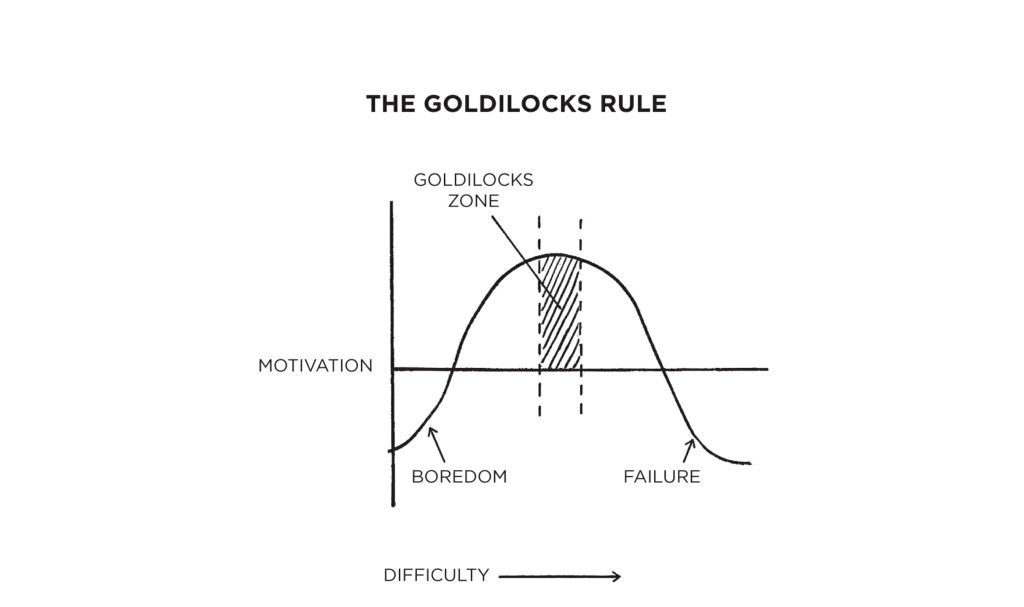
- Yerkes–Dodson law – Maximum motivation occurs when facing a challenge of just manageable difficulty.
- A flow state is the experience of being “in the zone” and fully immersed in an activity. To achieve a state of flow, a task must be roughly 4 percent beyond your current ability.
How to stay focused when you get bored
Mastery requires practice.
But the more you practice something, the more boring and routine it becomes.
- The greatest threat to success is not failure but boredom.
- Successful people feel the same lack of motivation as everyone else. The difference is that they still find a way to show up despite the feelings of boredom.
- Machiavelli noted, “Men desire novelty to such an extent that those who are doing well wish for a change as much as those who are doing badly.”
- The sweet spot of desire occurs at a 50/50 split between success and failure.
The only way to become excellent is to be endlessly fascinated by doing the same thing over and over.
You have to fall in love with boredom.
- Professionals stick to the schedule; amateurs let life get in the way.
- There have been a lot of articles I haven’t felt like writing, but I’ve never regretted publishing on schedule.
Habits create the foundation for Mastery.
- At first, each repetition develops fluency, speed, and skill. But then, as a habit becomes automatic, you become less sensitive to feedback.
- Once a skill has been mastered there is usually a slight decline in performance over time.
- Habits are necessary, but not sufficient for mastery.
- What you need is a combination of automatic habits and deliberate practice. Habits + Deliberate Practice = Mastery
Mastery is the process of narrowing your focus to a tiny element of success, repeating it until you have internalized the skill, and then using this new habit as the foundation to advance to the next frontier of your development.
Each habit unlocks the next level of performance. It’s an endless cycle.
How to review habits and make adjustments
A lack of self-awareness is poison. Reflection and review is the antidote.
- Top performers in all fields engage in various types of reflection and review, and the process doesn’t have to be complex.
- Improvement is not just about learning habits, it’s also about fine-tuning them.
Each December, I perform an Annual Review, in which I reflect on the previous year.
- I tally my habits for the year by counting up how many articles I published, how many workouts I put in, how many new places I visited, and more.
- I reflect on my progress (or lack thereof) by answering three questions: What went well this year? What didn’t go so well this year? What did I learn?
My yearly Integrity Report answers three questions:
- What are the core values that drive my life and work?
- How am I living and working with integrity right now?
- How can I set a higher standard in the future?
Reflection can also bring a sense of perspective.
How to break beliefs that hold you back
- When working against you, your identity creates a kind of “pride” that encourages you to deny your weak spots and prevents you from truly growing.
- The more sacred an idea is to us—that is, the more deeply it is tied to our identity—the more strongly we will defend it against criticism.
- In the words of investor Paul Graham, “keep your identity small.” The more you let a single belief define you, the less capable you are of adapting when life challenges you.
When chosen effectively, an identity can be flexible rather than brittle. Like water flowing around an obstacle, your identity works with the changing circumstances rather than against them.
Tao Te Ching encapsulates the ideas perfectly.
Men are born soft and supple; dead, they are stiff and hard.
Plants are born tender and pliant; dead, they are brittle and dry.
Thus whoever is stiff and inflexible is a disciple of death.
Whoever is soft and yielding is a disciple of life.
The hard and stiff will be broken.
The soft and supple will prevail.
– LAO TZU
CONCLUSION
The secret to results that last
There is an ancient Greek parable “Sorites Paradox”, which talks about the effect one small action can have when repeated enough times.
- The holy grail of habit change is not a single 1 percent improvement, but a thousand of them. It’s a bunch of atomic habits stacking up, each one a fundamental unit of the overall system.
- In the beginning, small improvements can often seem meaningless because they get washed away by the weight of the system.
- Gradually, though, as you continue to layer small changes on top of one another, the scales of life start to move.
Success is not a goal to reach or a finish line to cross. It is a system to improve, an endless process to refine.
- With the Four Laws of Behavior Change, you have a set of tools and strategies that you can use to build better systems and shape better habits.
- There is no finish line. There is no permanent solution.
- Whenever you’re looking to improve, you can rotate through the Four Laws of Behavior Change until you find the next bottleneck. Make it obvious. Make it attractive. Make it easy. Make it satisfying.
- The secret to getting results that last is to never stop making improvements.
Small habits don’t add up. They compound.
That’s the power of atomic habits. Tiny changes. Remarkable results.
Read More Like This
- Managing Oneself by Peter Drucker
- Start with Why by Simon Sinek
- Habits Create the Foundation for Mastery
Recent Articles

